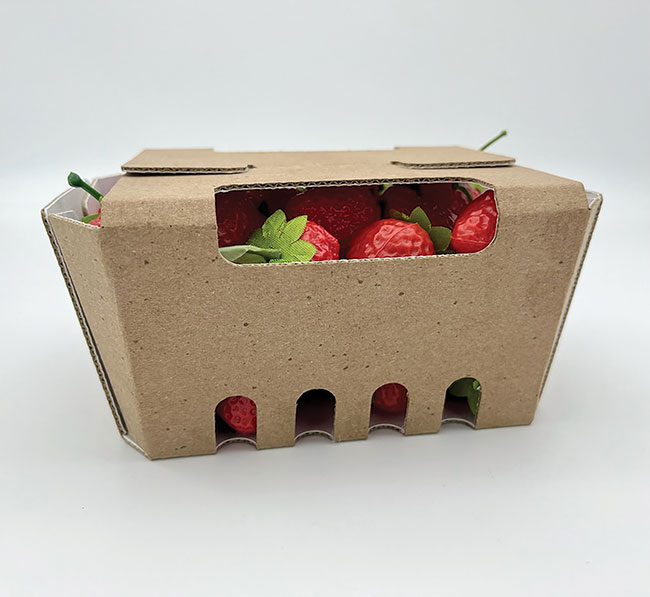
Features
Organic Perspective
Plastic-wrapped sustainability
Confronting problems with packaging organic products through innovation in the packaging industry with Wellington Produce Packaging.
February 21, 2023 By Stephanie Brunet, OCO
 Wellington Produce Packaging’s prototype recyclable, compostable clamshell packaging.
Photo courtesy of Wellington produce packaging.
Wellington Produce Packaging’s prototype recyclable, compostable clamshell packaging.
Photo courtesy of Wellington produce packaging. A major value of organics is the production of food in a sustainable, environmentally friendly manner. For an organic farmer to go through the process of obtaining certification and following organic regulations only to end up packaging their product in layers of plastic seems counterproductive.
In reality, organic produce typically involves significantly more plastic packaging than its non-organic counterpart, as many grocery chains rely on packaging to ensure organic products are scanned correctly at checkout counters. According to the Canada Organic Trade Association, 82 per cent of Canadians who buy organic products do so through major grocery chains. If all these organic products are being sold in grocery stores with heavy packaging requirements, organic produce could be responsible for a massive amount of plastic waste.
We spoke to Wellington Produce Packaging (WPP), an Ontario-based packaging manufacturer that has been in business for 88 years, to learn how our organic sector can make the most sustainable choices when it comes to packaging organics.
“We currently sell lots of the products we are aiming to replace, but we have the idea of ‘putting ourselves out of business before someone else does’ – we want to be the leaders of sustainable packaging in Canada,” says Adam Hincks, sales, WPP.
Is packaging unavoidable?
With grocery chains requiring some form of packaging for organic produce, some companies have gotten creative in minimizing their footprints. Eosta, a European distributor of organic produce, has developed laser technology that affects pigments on the peel of the fruit or vegetable, leaving a permanent mark on the produce and effectively eliminating the need for a label or packaging. While replacing packaging altogether might not be an option in Canada just yet, shifting away from single-use plastics (SUPs) is a vital step in mitigating the climate crisis.
WPP is currently developing cardboard clamshells that will compete directly with the plastic clamshells that are commonly used for berries. The cardboard clamshells are completely recyclable and can be torn into smaller pieces for compost, as they are manufactured using vegetable inks. The company is also working to increase the sustainability of its existing packaging; they are currently trialing a new material for green plastic strawberry quarts that can be broken down quickly by the bacteria present in landfills.
“We have achieved 10 per cent degradation in 100 days,” Hincks says. “This does not affect the recyclability of the product, and it also will not degrade on a customer if they want to wash and reuse. So it’s not perfect, but it’s a positive step!”
Green packaging vs. greenwashing
Selecting sustainable packaging becomes challenging for organic producers when the line blurs between the appearance of sustainability and its actuality. There are countless brands guilty of falsely marketing their packaging to producers as sustainable, a tactic known as “greenwashing.” WPP tells us that greenwashing can make it difficult to communicate sustainability honestly to organic producers. Scrutinizing green claims is time-consuming.
“Packaging is such a small part of their business that [organic producers] can’t afford to put a lot of time into researching,” Hincks explains. Emerging government regulations prioritizing sustainability could make greenwashing a less common occurrence in the industry.
New government regulations
The Government of Canada is introducing the Single-use Plastics Prohibition Regulations, which will ban plastic checkout bags, cutlery, foodservice ware, ring carriers, stir sticks and straws. The regulations are part of Canada’s goal to eliminate plastic waste by 2030. While the regulations are certainly a step in the right direction for the industry, they are not without flaws. The new regulations aim to protect the environment as soon as possible in response to the global climate crisis, but their implementation may prove to be sudden for some businesses.
“This is sort of like the industry has hit the iceberg,” Hincks explains. “Now we need to find a solution before the boat sinks. We hope it leads to positive results.”
Top-down changes
Another issue that organic farmers can face when choosing sustainable packaging is the requirements of their buyers. WPP once had a compostable packaging tray tested and approved by a farmer. However, the head office of the grocery chain they were selling to made them switch to plastic packaging after a few shipments.
“We were totally surprised by this, and frustrated by the lack of transparency in the decision. Big grocery chains dictate so much about what farmers can and cannot use as packaging. At the end of the day, changes need to come from them,” Hincks says.
“For organic growers especially, using sustainable packaging creates an excellent opportunity for marketing, as now your packaging communicates your ethos.”
Print this page